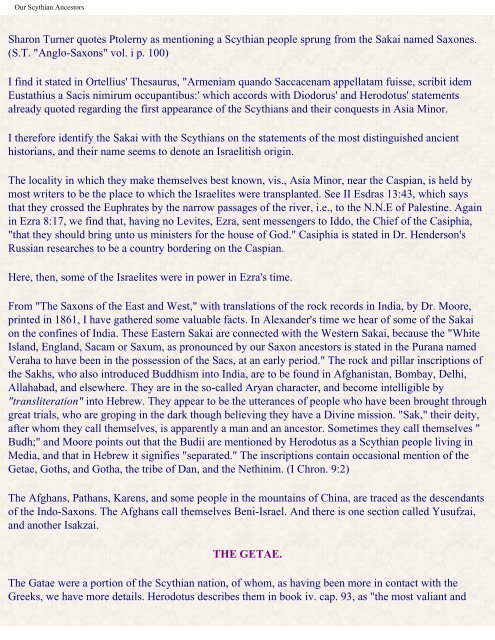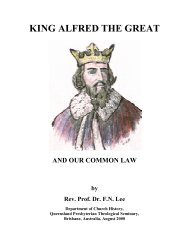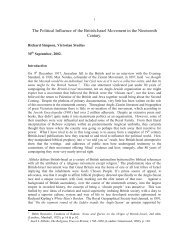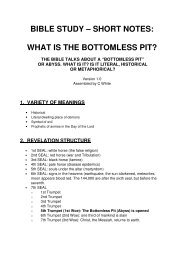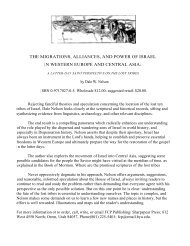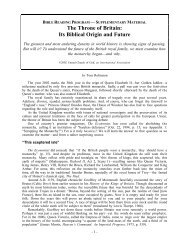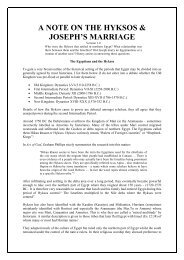<strong>Our</strong> <strong>Scythian</strong> <strong>Ancestors</strong>Sharon Turner quotes Ptolerny as mentioning a <strong>Scythian</strong> people sprung from the Sakai named Saxones.(S.T. "Anglo-Saxons" vol. i p. 100)I find it stated in Ortellius' Thesaurus, "Armeniam quando Saccacenam appellatam fuisse, scribit idemEustathius a Sacis nimirum occupantibus:' which accords with Diodorus' and Herodotus' statementsalready quoted regarding the first appearance <strong>of</strong> the <strong>Scythian</strong>s and their conquests in Asia Minor.I therefore identify the Sakai with the <strong>Scythian</strong>s on the statements <strong>of</strong> the most distinguished ancienthistorians, and their name seems to denote an Israelitish origin.The locality in which they make themselves best known, vis., Asia Minor, near the Caspian, is held bymost writers to be the place to which the Israelites were transplanted. See II Esdras 13:43, which saysthat they crossed the Euphrates by the narrow passages <strong>of</strong> the river, i.e., to the N.N.E <strong>of</strong> Palestine. Againin Ezra 8:17, we find that, having no Levites, Ezra, sent messengers to Iddo, the Chief <strong>of</strong> the Casiphia,"that they should bring unto us ministers for the house <strong>of</strong> God." Casiphia is stated in Dr. Henderson'sRussian researches to be a country bordering on the Caspian.Here, then, some <strong>of</strong> the Israelites were in power in Ezra's time.From "The Saxons <strong>of</strong> the East and West," with translations <strong>of</strong> the rock records in India, by Dr. Moore,printed in 1861, I have gathered some valuable facts. In Alexander's time we hear <strong>of</strong> some <strong>of</strong> the Sakaion the confines <strong>of</strong> India. These Eastern Sakai are connected with the Western Sakai, because the "WhiteIsland, England, Sacam or Saxum, as pronounced by our Saxon ancestors is stated in the Purana namedVeraha to have been in the possession <strong>of</strong> the Sacs, at an early period." The rock and pillar inscriptions <strong>of</strong>the Sakhs, who also introduced Buddhism into India, are to be found in Afghanistan, Bombay, Delhi,Allahabad, and elsewhere. They are in the so-called Aryan character, and become intelligible by"transliteration" into Hebrew. They appear to be the utterances <strong>of</strong> people who have been brought throughgreat trials, who are groping in the dark though believing they have a Divine mission. "Sak," their deity,after whom they call themselves, is apparently a man and an ancestor. Sometimes they call themselves "Budh;" and Moore points out that the Budii are mentioned by Herodotus as a <strong>Scythian</strong> people living inMedia, and that in Hebrew it signifies "separated." The inscriptions contain occasional mention <strong>of</strong> theGetae, Goths, and Gotha, the tribe <strong>of</strong> Dan, and the Nethinim. (I Chron. 9:2)The Afghans, Pathans, Karens, and some people in the mountains <strong>of</strong> China, are traced as the descendants<strong>of</strong> the Indo-Saxons. The Afghans call themselves Beni-Israel. And there is one section called Yusufzai,and another Isakzai.THE GETAE.The Gatae were a portion <strong>of</strong> the <strong>Scythian</strong> nation, <strong>of</strong> whom, as having been more in contact with theGreeks, we have more details. Herodotus describes them in book iv. cap. 93, as "the most valiant and
<strong>Our</strong> <strong>Scythian</strong> <strong>Ancestors</strong>most just <strong>of</strong> the Thracians."When Darius made his expedition against the <strong>Scythian</strong>s, B.C. 500, he calls those occupying the southbank <strong>of</strong> the Danube Gatae, and those on the north bank he calls <strong>Scythian</strong>s. Arrian, in his account <strong>of</strong>Alexander's expedition, gives the name <strong>of</strong> Gatae to the people who occupied both banks (Arrian, cap.iii.). He says that there were many boats on the Danube for fishing, commerce, and piracy. But the fullestdescription embodying the accounts <strong>of</strong> various authors is given by Abraham Ortellius in his TheatrumOrbis Terrarum. (British Museum, c. 46 I., under head <strong>of</strong> Dacia et Moesia.)"The Inhabitants <strong>of</strong> Dacia, the Greeks call Daci, the Latines Gatae, as Pliny, Doin, Stephanus, and othersdo testify: (this also Cottiso, sometime the king <strong>of</strong> that nation, doth confirm; whom Suetonius nameth theking <strong>of</strong> the Getes; Horace calleth him Dacum a Dake:) item Iornandes saith that the Romans indifferentlycalled thern Daci, or Gothi. I do observe that Herodotus and the writers about that age generally,comprehended them under the name <strong>of</strong> the Scythae, <strong>Scythian</strong>s; to whom also the aforesaid Iornandesdoth wholly assent and agree."Moreover, Arrianus writeth that the Gatae were also called Apanthonizontes; but it is to be amended,and out <strong>of</strong> Herodotus' first book to be written Athanatizontes, as who say immortals, for they [sic] doverily believe that they shall never die, but after their departure out <strong>of</strong> this life go presently unto oneZamolxis, a saint or idol which they do specially worship and adore.""..... Strabo in the seventh book <strong>of</strong> his Geography, and Virgil in the third <strong>of</strong> his Georgicles, do speake <strong>of</strong>the desertes and wildemesses <strong>of</strong> the Gatae. The same author calleth it 'gentem idomitam' au unrulienation. Statius saith that they are hairie, unshorne, furred or clad in skins, inhumane, sturdy, stern,wearing long side breeches and mantles (like our Irishmen)." I read in Pliny, that they used to paint theirfaces ( like unto our Britains). That there is not a more stern nation Ovid the poet very truly wrote <strong>of</strong>them. Vegetius, who wrote <strong>of</strong> the art <strong>of</strong> war, saith that it is a very warlike people, having, indeed, as theprince <strong>of</strong> poets testifieth, God Mars for their lieutenant and governor. Of Claudian it is namedBellipotens, a mighty nation for warlike men."They were in time past so strong, as Strabo writeth, that they were able to make an army <strong>of</strong> 200,000men. Josephus, in his second book against Appian " (Antiq. xviii. 1,5 ?), "writeth, There are a certainkind <strong>of</strong> Dakes, commonly called Plisti, whose manner <strong>of</strong> life be compareth to the course <strong>of</strong> life <strong>of</strong> theEssenes. These I do verily believe are the same with those which Strabo calleth Plistae, and were <strong>of</strong> thestock <strong>of</strong> the Abii" ( a <strong>Scythian</strong> tribe mentioned by Arrian as "the justest people in the world.")These Essenes were a highly moral and sedate sect <strong>of</strong> the Jews: very much resembling our Quakers intheir manner <strong>of</strong> life; they were very much attached to the books <strong>of</strong> Moses. They are described byJosephus in Antiquities <strong>of</strong> the Jews (book xviii., cap. i., ii., and viii.). In cap i sec. 5 he says <strong>of</strong> them:-"They ascribe all things to God, they teach the immortality <strong>of</strong> souls, and esteem that the rewards <strong>of</strong>righteousness are to be earnestly striven for. They exceed all other men that addict themselves to virtue,and this in righteousness. They do the most resemble those Daci who are called Polistae."


